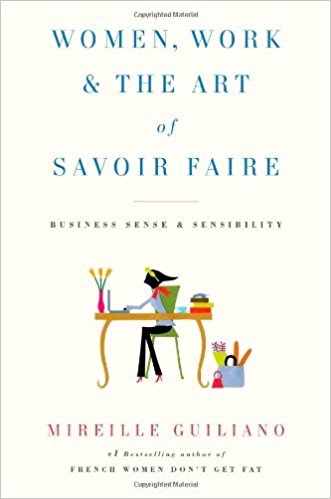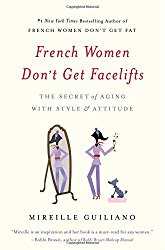

I have posted about Mireille Giuliano before, notably in reviewing her first book, French Women Don’t Get Fat. I truly love that book and re-read it periodically. To me, it’s a sound, common-sense set of principles for getting and staying slim no matter what your nationality, and I ignore the ideas that are just kind of silly. Sorry, Mireille, but very few people who live in America visit France often enough to buy their prunes there. (Of course, that’s assuming that you buy them at all . . . ) And we don’t go mushroom hunting much around here. Nor do we have blueberry bushes in the back yard to supply us with those little nutritional powerhouses. Nor do we divide our time between New York City and Provence, where there are excellent farmers’ markets year-round. (I always wonder whether or not Mireille ever goes into a regular supermarket. Probably not!) I ran into an interesting article in the UK newspaper The Guardian (but now I can’t find it) in which some Frenchwomen were interviewed about how they view their weight, and they said that Mireille’s book was a big, fat (sorry) pain in the neck because it perpetrated the myth of always-thin French women. But, and this is a very important but, those interviewees weren’t really following the FWDGF principles. Instead, they were making a practice of overindulging at restaurants, because it’s supposedly frowned upon not to eat a lot when you’re out on the town, and then starving themselves the rest of the time. Not, not, not what Mireille says to do! She would say, in her charming French accent, “Who cares what’s considered cool or not cool? You eat the way you want to, and if people don’t like it, tant pis!” (Or, as my mother used to say, “If they don’t like it, they can lump it!”) So there it is.
Anyway, I had been reminded lately of Mireille and had gotten a couple of her later books from the library via the great service called Hoopla. (Be sure to check and see if your library has this resource.) I made it only about halfway through Women, Work and the Art of Savoir Faire: Business Sense and Sensibility (2009). Her story of getting into the Champagne business and then becoming the CEO of LVMH, the umbrella corporation for Veuve Cliquot and other luxury brands marketed in the US, is really quite fascinating and a good template for anyone who wants to succeed in the business world. While I’m supremely uninterested in getting people to drink Champagne, I’m very interested in getting them to read my books. Reading about Mireille’s business savvy in publicizing the VC brand was a good nudge for me. (“Veuve Cliquot” means “The Widow Cliquot,” and Madame Cliquot was probably the first modern woman to run a major corporation, taking over the family Champagne business in 1805 after her husband died.)
So, for instance, Mireille capitalized on using her very small advertising budget in the early days when VC had only a tiny portion of the US market by making sure that the color of the label for VC’s signature Champagne, the “yellow label” (but actually more of an orange), became strongly associated with the product itself. (Just like Tiffany blue, I guess, although very few of us will ever get a piece of jewelry in one of those signature blue boxes!) She bought up a lot of radio ads at a good price and then did the spots herself, as everyone liked her voice and accent, thus saving money on hiring a voice-over artist. She got stores to put big displays of the yellow-labeled bottles in their windows during Halloween, with the orange-y color fitting in perfectly with the season. And so on. I was inspired to do some advertising myself for my newest book, this one on the lyrics of Carmina Burana, by getting onto a great website, ChoralNet, and placing a classified ad, as this site is particularly aimed at choral directors, the very people whom I want to reach. And the ad is free. I also have made sure to publicize my book by giving away free (digital) copies to the members of The Cherry Creek Chorale, as my first writing about the meaning of musical texts was done, and continues to be done, for them. I’ve asked them to spread the word. There’s much more to do in this regard, though, and so I need to just reach out and contact people. All they can do is say no! Targets of opportunity are the publisher of Carmina Burana and companies that sell recordings of individual parts for masterworks. And I have material I could use for booklets on Mendelssohn’s Elijah and Mozart’s Requiem, so I need to get busy on those.
Well! I’ve gone on and on about the book I didn’t finish, leaving me very little space to write about the one that I did, French Women Don’t Get Facelifts: The Secret of Aging with Style & Attitude. But I don’t know that I need to say much, because I would really recommend that you read it for yourself. Sometimes these book reviews are just meant to give you the gist of the material, perhaps whetting your appetite but possibly satisfying it instead. That would probably be the case for the book above. I can’t imagine what else she talked about for the last half of the book! I had gotten more than enough about how to be an effective businesswoman in what I read. But the facelift book is very different in that she covers a whole range of issues about aging gracefully. I loved the early chapters about dressing well and taking good care of yourself, although you wouldn’t believe how many words she used in describing how to shampoo your hair! And how to play the French game of pétanque (although she does have a charming story about that one). But in the last chapters she moves into much more serious topics, including some ideas on taking responsibility for your finances and for finding satisfying work to do, paid or unpaid, as you move into retirement. She even has a whole section about all the medical advances that have given us artificial joints and teeth as well as various life-extending surgeries and treatments. I found those chapters to be a bit uncomfortable, to be honest, as she is herself brutally honest about how to prepare for your later years. In the end, though, I was glad for her straightforward approach.
So, while I am wedded to my jeans (a clothing item that Mireille refuses to wear) and my comfortable walking shoes, and while I stopped coloring my hair over a decade ago, I still found her advice on remaining stylish and graceful to be, once again, a good nudge. How much better to embrace your maturity and experience, to develop your own personal style and signature, than to bemoan the passage of time! (And, by the way, I had considered—just considered, mind!–the possibility of getting some Botox treatments on my forehead, not so much as a way to look younger but as a way not to look as if I’m frowning all the time. But Mireille convinced me to give up that idea, preliminary as it was. I was instead nudged to use nightly the little stick-on anti-frown-line patches that I bought some time ago. They’re quite inexpensive and do seem to make a difference, if I use them regularly.)
Well, c’est ça: that’s it. Read or listen to the book! I think you’ll be glad you did, whatever your age.